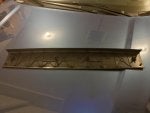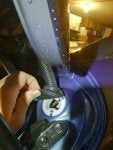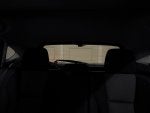I think the front dash cam install is easy enough, so I'm not posting about it, but I recently installed a rear 'dashcam', and there wasn't a lot of knowledge on this forum (that I could find) about it, so I just want to share my pictures and experience.
Please note that I am using a Blacksys CH-100 system with a rear camera connected via USB cable.
Now the rear camera is trickier than the front for a few reasons. First, if you want to run it through the hatch, there is some complications there, and additionally, especially if running along the top, one has to be mindful of the side curtain airbag.
Now I don't know if my method is perfect, but this is what I did. Please don't hold me responsible for your install, I am not an expert, and this is only what I have done.
First step was taking the rear window upper trim panel: I didn't exactly know where all the clips were, so it took me a while since I didn't want to break anything. But this picture here should show where all of those clips are to help you:
![]()
Once the trim piece is taken off, I popped off the headliner and the rubber gasket/tubing. There are two of these on the hatch, but I chose to take it through the right side tubing since there was more available space in the tubing. The left side one carries a thick tube for the windshield wiper fluid, so I found the right to be easier to pass the cable through. The top of the tubing is easy to remove, but the bottom has a plastic lip that looks like this.
![]()
At this point, I had to remove the headliner. I popped it in front of the plastic trims, and also removed the three circular clips in the back to allow the headliner to drop down slightly. After slipping the wire behind the headliner, you will be able to see that there is some room to pass the cable through that bottom hole where the tubing comes out of. It took a few tries for me, but I was able to finagle the wire eventually.
![]()
I was able to pull the cable through to give me some slack and slowly pushed it through the rubber tubing. This part was challenging since the plug was pretty big, and took quite some time to get through. Re-seating the rubble gaskets is a little challenging, but make sure you get it seated back in correctly, because these are designed to keep water from entering the inside of your car frame.
![]()
Once that was done, I put the cable in place, popped the trim back on and left just the short end of the cable dangling out. Note that there is a bit of flex in this panel, and I did not see the need to drill through it, and simply wired the cable through the middle.
![]()
Please note that I am using a Blacksys CH-100 system with a rear camera connected via USB cable.
Now the rear camera is trickier than the front for a few reasons. First, if you want to run it through the hatch, there is some complications there, and additionally, especially if running along the top, one has to be mindful of the side curtain airbag.
Now I don't know if my method is perfect, but this is what I did. Please don't hold me responsible for your install, I am not an expert, and this is only what I have done.
First step was taking the rear window upper trim panel: I didn't exactly know where all the clips were, so it took me a while since I didn't want to break anything. But this picture here should show where all of those clips are to help you:

Once the trim piece is taken off, I popped off the headliner and the rubber gasket/tubing. There are two of these on the hatch, but I chose to take it through the right side tubing since there was more available space in the tubing. The left side one carries a thick tube for the windshield wiper fluid, so I found the right to be easier to pass the cable through. The top of the tubing is easy to remove, but the bottom has a plastic lip that looks like this.

At this point, I had to remove the headliner. I popped it in front of the plastic trims, and also removed the three circular clips in the back to allow the headliner to drop down slightly. After slipping the wire behind the headliner, you will be able to see that there is some room to pass the cable through that bottom hole where the tubing comes out of. It took a few tries for me, but I was able to finagle the wire eventually.

I was able to pull the cable through to give me some slack and slowly pushed it through the rubber tubing. This part was challenging since the plug was pretty big, and took quite some time to get through. Re-seating the rubble gaskets is a little challenging, but make sure you get it seated back in correctly, because these are designed to keep water from entering the inside of your car frame.

Once that was done, I put the cable in place, popped the trim back on and left just the short end of the cable dangling out. Note that there is a bit of flex in this panel, and I did not see the need to drill through it, and simply wired the cable through the middle.















